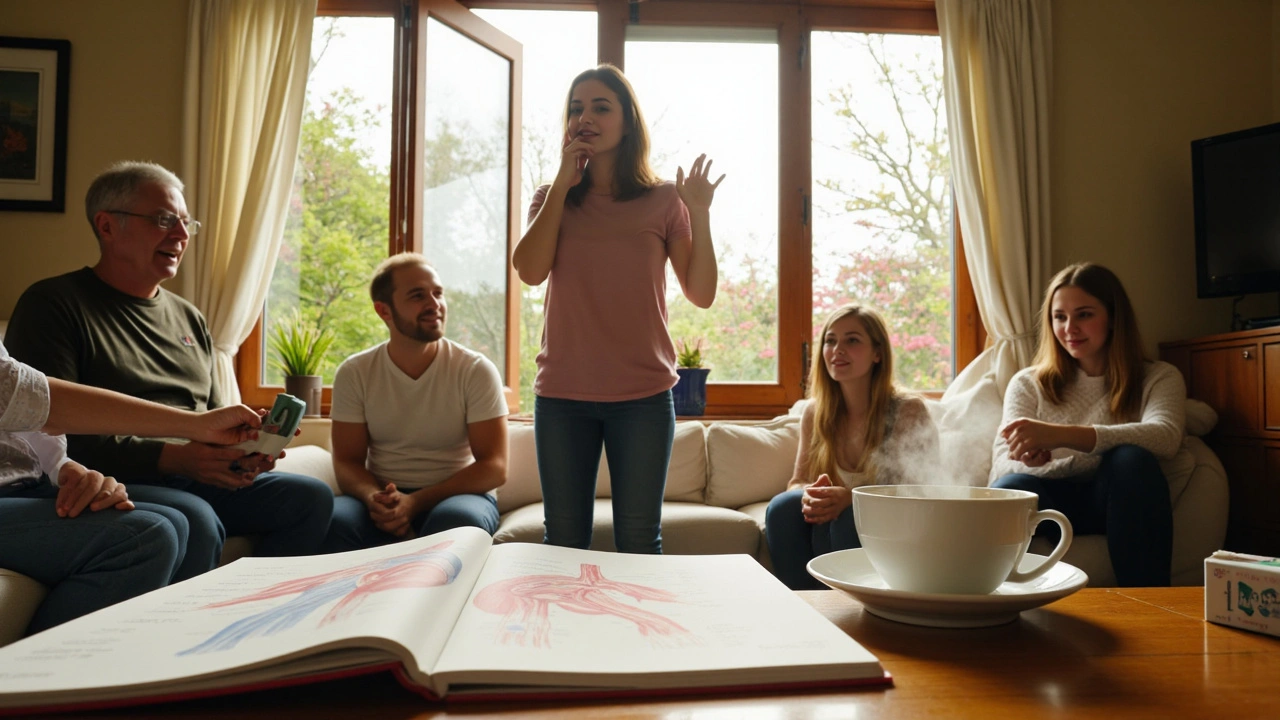Lymphatic Drainage Massage: Top Benefits for Boosting Health and Wellbeing

Feeling sluggish for no clear reason? Bloated after a long day, or dealing with nagging aches that just never let up? You’re not alone—buried beneath everyday routines, many of us ignore just how much our lymphatic system does to keep us feeling our best. Tucked away in your body is a whole network that’s quietly sweeping away waste, fighting infection, and helping you bounce back from sickness or stress. Now, more than ever, people across Bristol and beyond are discovering that a lymphatic drainage massage isn’t just some trendy spa ritual—it’s a practical way to tap into better health. You might’ve seen the before-and-after photos on social media, or heard friends rave about dropping inches overnight. But what’s really going on with this massage—and what can you truthfully expect from it? Let’s dig into those facts, and bust the myths along the way.
How the Lymphatic System Works and Why It Matters
Most people can point to where their heart or lungs are, but the lymphatic system? That’s less obvious, yet absolutely vital. Think of it as the body’s cleaning crew and immune defense rolled into one. This network includes about 600 to 800 lymph nodes mapped across your body, plus miles of vessels. Every day, these silent pipes pick up extra fluid and toxins from your tissues, and return clean fluid back to your bloodstream. Did you know the lymphatic system moves almost two to three liters of fluid daily? That’s a massive amount when you realise blood only circulates about five liters per minute—but lymph moves much slower without its own pump. Instead, it relies on breathing, movement, and muscle activity. Sedentary jobs, tight clothing, injuries, or even surgery can slow this flow and cause waste to back up. You might notice puffiness, heavy legs, recurring infections, or random exhaustion if your lymph is sluggish.
That’s where science says lymphatic drainage massage comes in handy. Unlike classic massages focused on deep muscle work, this style uses light rhythmic strokes aimed at moving lymph toward lymph nodes to help it drain out. The method was first developed in the 1930s by Danish doctors Emil and Estrid Vodder, and has since changed the lives of cancer survivors and those recovering from surgery, injury, or chronic swelling (lymphedema). Lots of research in UK hospital settings supports its benefits. One NHS-published study found that manual lymphatic drainage reduced limb swelling and pain for breast cancer patients by up to 50%. Not bad for gentle hands-on care that doesn’t involve drugs or side effects. But even if you haven’t had surgery or illness, clogged lymph—whether from sitting too long, stress, or a night of drinking—can leave you feeling tired and foggy-headed. That’s why regular lymphatic drainage massage is becoming popular for maintaining daily wellness, not just treating illness.
Surprising Health Benefits Backed by Real Experience
So, what can you actually expect if you try lymphatic drainage massage yourself? The most striking difference people usually notice in the first session is reduced swelling, especially around the face, ankles, or abdomen. If you’ve ever woken up puffy-eyed, or struggled to fasten your jeans by evening, you’ll relate. Clients with swelling after long flights (think that weird sock imprint on your leg after sitting in a cramped plane), sprains, or even post-surgery fluid often report they feel lighter and less stiff immediately after one massage. There’s even a viral trend in major UK cities showing side-by-side photos: in many, waistlines visibly shrink as built-up fluid leaves the tissues.
But it’s not just about looks—there are deeper health benefits here. The light touch of lymphatic drainage massage relaxes the nervous system, which is why many fall asleep during sessions. Research in 2023 by King’s College London revealed that regular weekly sessions helped 60% of their participants manage anxiety, lower daily pain scores, and sleep better. People with chronic fatigue, fibromyalgia, or arthritis have all reported less pain and swelling, plus a clearer mind. Immune health gets a real boost, too. Lymphatic massage kick-starts white blood cells into action, which means you’re less likely to catch every cold or flu passing by at work or school. For those post-op or healing after injury, studies show this hands-on care can reduce infection risk and speed up recovery by as much as 30% compared to rest alone.
Ever had brain fog after a tough week, or noticed you get sick more often after stressful periods? That’s your lymph working overtime. By keeping the system unclogged, massage helps both your brain and immune system stay sharp. On top of this, people who get regular lymphatic drainage swear by an uptick in energy. They report going from dragging their feet to feeling keen to hit the gym or run errands they’d been putting off for days. If you’re struggling with seasonal allergies, sinus trouble, or tired skin, regular treatment can help move fluid build-up in the face, opening airways and reducing pressure. Many dermatologists in Bath and London recommend lymphatic massage for post-cosmetic procedure care and glowing, less-reactive skin. No fancy serums required—just a boost to what your body already does naturally.

What a Lymphatic Drainage Massage Actually Feels Like
Expect something quite different from your usual deep sports massage. Lymphatic drainage feels almost feather-light. Skilled therapists use precise, slow hand movements that may seem too gentle to do anything, but that’s the point. Press too hard, and you’ll squash those delicate lymph vessels right shut. A typical session lasts somewhere between 60 and 90 minutes, with particular focus on areas that are swollen or prone to fluid buildup—think ankles, thighs, abdomen, and face. There’s almost a rhythmic, wave-like pattern as hands move lymph fluid towards lymph nodes clustered near your neck, underarms, and groin. You don’t need expensive spa equipment: most clinics use basic massage tables and medical-grade oils only if needed for comfort.
During the massage, you might feel a gentle warming sensation as circulation improves. Some people say they taste metal or get thirsty as toxins start to shift out. Don’t worry—that’s normal. After the session, it’s common to need the loo more often, since your kidneys are processing the extra fluid. Pro tip: Drink water before and after, to flush out the waste more efficiently. Most therapists recommend wearing loose, comfortable clothes and avoiding alcohol or salty food for 24 hours afterward to see the best results. Some folks get mild euphoria or light-headedness—just a sign your lymphatic system is finally getting a spring clean. For best results, especially after illness or surgery, a course of several weekly sessions is ideal. People with ongoing issues like lymphedema or sluggishness often work out a maintenance plan with their therapist—a bit like a personal trainer for your immune system.
Want to try a bit at home? Some simple techniques include skin-brushing with a natural bristle brush or doing self-massage along the jaw, collarbone, and belly. Gentle bouncing exercises, brisk walks, and even yoga twists all help get lymph fluid moving. If you’re curious about what’s going on under the surface, here’s a quick snapshot:
| Function | Lymphatic Massage Effect |
|---|---|
| Fluid Removal (ml/hour) | Up to 100 extra per hour during treatment |
| Swelling Reduction | Visible within 24-48 hours for mild cases |
| Pain/Discomfort Relief | Rating drops by 30-50% after 2-3 sessions |
| Recovery Speed After Surgery | Average healing 20-30% faster |
| Metabolic Toxin Flush | Increased urine and sweat output |
Tips for Getting the Most Out of Your Lymphatic Drainage Massage
If you’re paying for a massage, you want every minute to count. Start by picking a therapist specifically trained in lymphatic drainage—they should be able to tell you where they trained and who certifies them (look for Vodder, Casley-Smith, or Leduc trained practitioners in the UK). Before your session, skip heavy meals and drink water. Let your therapist know if you’ve had any surgeries, medical conditions, or ongoing swellings—they’ll customise the session to your needs. During the massage, just focus on relaxing and breathing deeply. The lighter the touch, the more effective it is for your lymph system. If your therapist uses hard pressure, that’s a sign they’re not doing the correct technique.
Afterwards, get moving—take a brisk walk or try a short stretching routine. This helps keep lymph fluid flowing and stops it from pooling again. Keep up your water intake for at least a day after the massage; your body is working hard to flush out everything stirred up during treatment. If you notice a burst of energy or a dip in swelling, try scheduling regular sessions, especially if you sit long hours or don’t move much during the week. Sticking to once a month is fine for prevention, while deeper issues might need weekly attention for a couple of months before tapering off.
Here’s a useful checklist for anyone considering their first session:
- Check for contraindications—avoid massage if you have fever, infection, severe heart problems, or clots, unless approved by your doctor.
- Ask your therapist for ‘before and after’ photos or swelling measurements—they often keep records to track progress.
- Pair your treatments with simple lifestyle steps: skin brushing, movement, and a balanced diet loaded with fresh produce (think anti-inflammatory berries, ginger, and leafy greens).
- Watch for signs of improvement: less puffiness, more energy, fewer colds, and easier sleep.
- Be patient: while you might notice amazing results after the first session, chronic or post-surgical swelling might need several weeks for best results.
Lymphatic drainage massage isn’t a magic bullet, but it’s a powerful, science-backed way to keep your inner plumbing in top shape. If you’re tired of feeling puffy, foggy, or worn out, giving your lymphatic system some attention could be the reset you didn’t know you needed.




John Bothman
August 1, 2025 AT 16:53I've always been intrigued by holistic health approaches, and lymphatic drainage massage seems like a fascinating topic. It's amazing how our body has this whole complex system quietly working behind the scenes, clearing toxins and keeping us balanced. From what I understand, this type of massage can stimulate the lymph nodes and vessels to help flush out wastes more efficiently.
Plus, the idea that it can ease swelling and pain makes me think it’s not just a luxury but a real health booster. I wonder how often one would need it to see lasting benefits. Also, are there any risks or side effects to watch out for? I'd be curious to hear experiences from people who incorporate it regularly into their wellness routines.
Overall, exploring these alternative wellness methods feels like a way to better connect with our bodies. It's a reminder that healing and prevention don’t only come from meds or surgery but from understanding and supporting the systems we usually take for granted.
mike morgan
August 2, 2025 AT 04:00Frankly, I am skeptical about the so-called benefits promoted here. It's easy to fall for health fads that lack concrete scientific validation. Stressing 'detox' and 'boost energy' often feels like empty buzzwords, designed to exploit vulnerable individuals desperately searching for quick fixes.
The lymphatic system is complex, yes, but the body has evolved efficient mechanisms to manage it without fancy massages. If you really want health, focus on proven diet, exercise, and medical advice instead of chasing after anecdotal claims.
Furthermore, should we let enthusiasm cloud our judgment and embrace questionable therapies? Absolutely not. It's a slippery slope of pseudoscience and charlatanism. We must remain vigilant and uncompromising in demanding rigorous evidence before endorsing such interventions.
Beth Wylde
August 2, 2025 AT 17:53This article touches on an important yet often overlooked aspect of self-care — the lymphatic system. I appreciate how the post highlighted not just the physical benefits but also the overall enhanced sense of wellbeing people feel after these massages.
Personally, I've experienced reduced swelling after sessions and a calming effect that lasts days. The body's energy can seem more balanced, almost like the massage resets internal harmony.
Of course, such complements should not replace medical treatment, but as part of a holistic wellness journey, it's invaluable. Listening to our bodies and respecting their natural rhythms can open doors to deeper health and peace.
I would love to see further research on this topic and encourage everyone to consult professionals before starting any new therapy.
Ellen Smith
August 3, 2025 AT 07:46While the article is informative, I must point out a few inaccuracies regarding the scientific backing of lymphatic drainage massage. The claims about detoxing and boosting energy, although commonly stated, lack substantial clinical evidence to fully endorse them.
From a linguistic perspective, the author did well in maintaining clarity and coherence, which I appreciated. However, I would recommend citing peer-reviewed studies or linking authoritative sources to strengthen the credibility.
Moreover, it's essential to communicate that such massages are complementary at best and not a replacement for medical interventions.
Bruce Shortz
August 3, 2025 AT 21:40I tried lymphatic drainage massage after reading about its benefits for swelling around the ankles. Honestly, it made a noticeable difference! The swelling reduced markedly, and I felt lighter afterward. It was like my limbs had been unclogged.
However, it took a few sessions before I really felt those benefits. No miracle overnight results, but gradual improvement. From an informal standpoint, if you’re dealing with chronic swelling or post-surgical recovery, it might be worth exploring.
Of course, everybody's experience varies, and talking to a healthcare professional is definitely a smart move before diving in.
Brenda Loa
August 4, 2025 AT 11:33One must approach the fascination with lymphatic drainage massages with a discerning eye. While the purported benefits are tantalizing, it's often those who embrace such treatments with a near religious fervor who lose sight of evidenced-based medicine.
The article skims over the complex physiology of the lymphatic system, choosing rather to rely on vague promises of detox and energy boosts. Intellectual rigor demands that we seek comprehensive clinical data and avoid the trap of superficial wellness trends.
In my experience, true health restoration is far more nuanced than fleeting massage sessions masquerading as panaceas.
Zackery Woods
August 5, 2025 AT 01:26Ah, the lymphatic drainage massage—yet another cog in the grand wheel of the wellness-industrial complex designed to bloat profits under the guise of health. While the promises of detoxification and energy boosts sound majestic, one must ask: who really benefits? Spoiler alert—it’s not always the ‘clients.’
Many so-called benefits here are more placebo than physiological reality. The body’s detox organs—liver, kidneys—do their job quite well without ritualistic hand gestures over the skin. It’s easy to sell snake oil wrapped in pretty packaging to the desperate and the uninformed.
Beware the colorful claims and marketing jargon; always question what lies behind the curtain of supposed wellness miracles.
Yvonne LaRose
August 5, 2025 AT 15:20This post wonderfully addresses how lymphatic drainage massage can contribute to improved health — not just physically but energetically too! 😊💫
The lymph system is often overlooked in medical discussions yet plays such a critical role in immune function and fluid balance. Specialized massage techniques can stimulate the flow of lymph, helping reduce swelling and detoxify tissues, which ultimately supports our body’s innate healing processes.
Integrating these therapies with a wholesome lifestyle — including adequate hydration, balanced nutrition, and mindful stress management — creates a synergistic effect that enhances wellbeing tremendously.
I'd be thrilled to see more integrative healthcare providers adopt and recommend lymphatic massage as part of a comprehensive health toolkit!!! ✨✨✨
Lisa Kulane
August 29, 2025 AT 08:46The emphasis on lymphatic drainage as a cure-all conveniently ignores that most of these benefits lack rigorous academic endorsement and border on pseudoscience. It's quite irritating how such content masquerades as informative when it panders to an audience thirsty for effortless health solutions.
Medical integrity requires discipline and evidence, not fanciful narratives about 'boosting energy' or 'detoxing.' If such massages were truly so beneficial, why isn't this a mainstream recommendation by licensed healthcare practitioners?
One must critically evaluate health claims and not succumb to the latest fad or anecdotal hysteria.
Rob e
August 31, 2025 AT 02:26I’ve done quite a bit of digging on therapies like lymphatic drainage, and here’s my take. Yes, it can feel relaxing, and some people report less swelling and more energy afterward. 🙂 But scientifically speaking, there’s still quite a bit of gray area.
A lot rides on the placebo effect or just the benefit of slowing down and focusing on self-care, which obviously can’t be discounted. However, for serious conditions, this is no substitute for medical treatment.
Personally, I’d say if it helps you feel better mentally and physically, that’s great! Just don’t expect it to be a miracle cure, and always consult proper health professionals before altering any treatment plans.